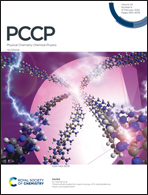Anion-binding of a chiral tris(2-aminoethyl)amine-based tripodal thiourea: a spectroscopic and computational study†
Abstract
Thioureas are well-known structural motifs in supramolecular anion recognition. Their conformational preferences are typically characterized by detailed NMR spectroscopy and crystallography, which are often complemented with computational results from geometry optimizations. Herein we investigate a chiral tris(thiourea) based on tris(2-aminoethyl)amine, which acts as an anion receptor for chloride and hydrogen sulfate. We show that a detailed NMR analysis led to a rather ambiguous picture of the conformational preferences of 1 in its complexes. The computational results were found to depend heavily on the selected computational level (functionals with or without dispersion corrections) and relative energies (zero-point corrected vs. Gibbs free energies) used for the calculation of the Boltzmann weights. Only the in-depth analysis of the experimentally observed vibrational circular dichroism (VCD) spectra and comparison with computed spectral signatures allowed us to reveal the actual chiral binding orientation in chloroform solution.



 Please wait while we load your content...
Please wait while we load your content...